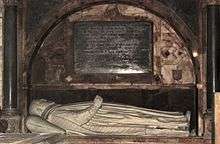Gerard Johnson (sculptor)

Gerard Johnson (Dutch: Gheerart Janssen; fl. 1612–1623) was a sculptor working in Jacobean England who is thought to have created Shakespeare's funerary monument. In May 1612 he was paid for making part of a fountain for the east garden at Hatfield House, Hertfordshire.[1]
His father, Gerard Johnson the elder, came to England in 1567 from Holland. He established himself as a sculptor of funerary monuments in London. Johnson's father had worked on a monument to the 1st Earl of Southampton, which also depicts Shakespeare's patron, the 3rd Earl, as a young man. Shakespeare would probably have seen the monument if he had stayed at Titchfield.[2]
The younger Johnson's monument is in Holy Trinity church, Stratford upon Avon, and was probably commissioned by Shakespeare's son-in-law John Hall. The attribution to Johnson is contained in Sir William Dugdale's Antiquities of Warwickshire, published in 1656, but no other evidence of Johnson's authorship exists. Dugdale also states that the younger Johnson created the memorial in Holy Trinity church to Shakespeare's friend John Combe, who left the playwright a legacy in his will. This would probably have been installed in 1615 while Shakespeare was still alive. It is also possible that Shakespeare knew the Johnson family from his London days, since their workshop was close to the Globe theatre.[3]
In 1849 a death mask was discovered in Germany, and was claimed to be Shakespeare's. It received great publicity when the anatomist Richard Owen authenticated it and suggested that it was used by Johnson as the model for the memorial. Henry Wallis later painted this imagined scene validating the mask. The mask is no longer considered to be authentic.
References
- ↑ White, Adam. "Johnson (Janssen) family (per. c.1570–c.1630)". Oxford Dictionary of National Biography, Oxford University Press, 2004 , accessed 16 Feb 2013.
- ↑ Martineau, Jane. Shakespeare in Art, Merrell, 2003, p.21
- ↑ Cooper, Tarnya. Searching for Shakespeare, National Portrait Gallery, 2006, p.51.
Gallery
-

The monument in situ
-

Close-up of the sculpture
-

The tomb of John Combe
